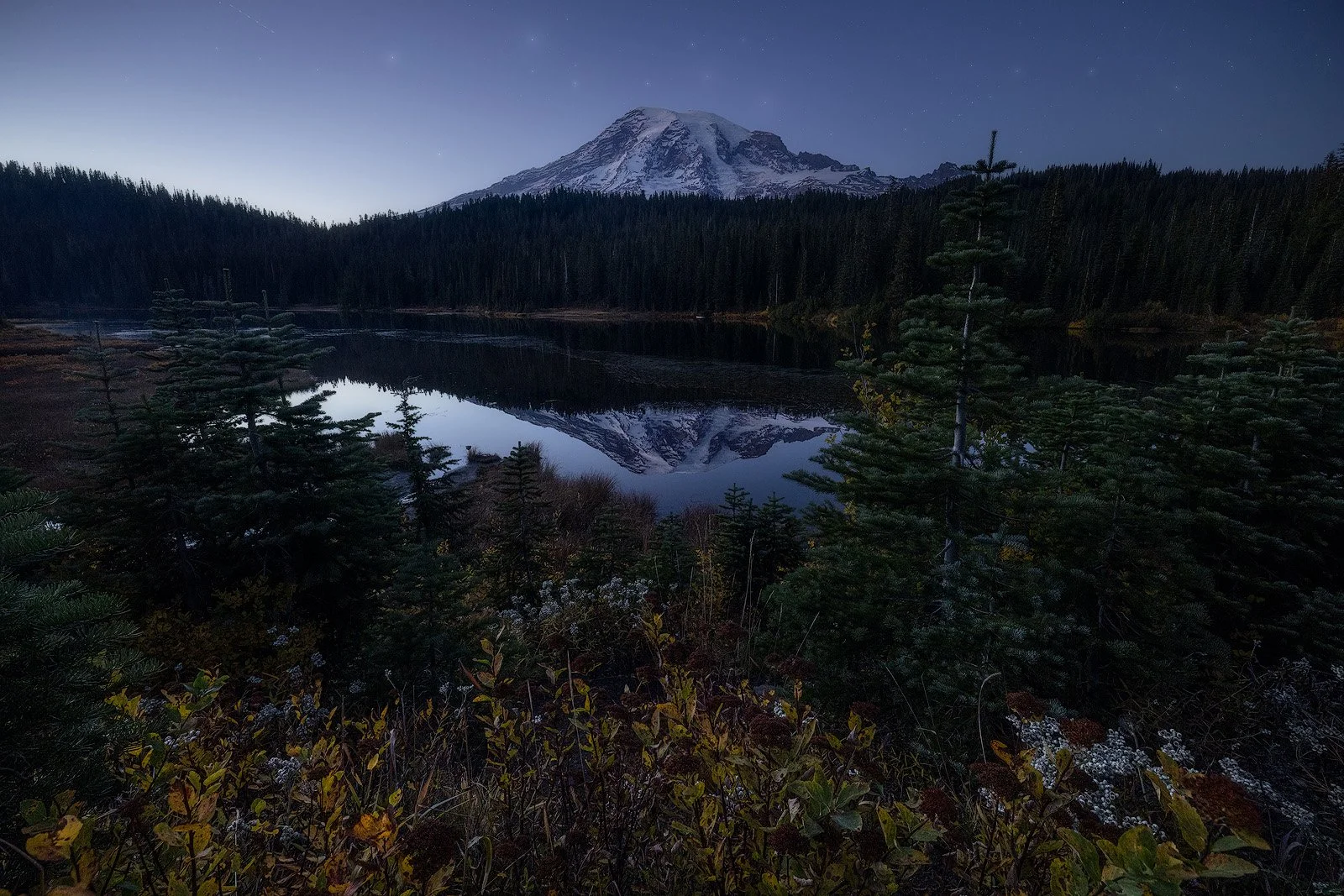 Image 1 of 1
Image 1 of 1


The Mountain Dreams Twice
Before dawn, Reflection Lake lies perfectly still beneath the towering presence of Mount Rainier. The mountain rises in frosted silence above the dark treetops, its snow-clad summit brushed with the faintest blush of morning. In the glassy surface below, that same peak appears again—so precise in detail that sky and water seem indistinguishable. For a few suspended minutes, the Pacific Northwest holds its breath: two mountains, one real and one imagined, bound by light and reflection. Overhead, a scatter of stars lingers in indigo, fading as the horizon begins to pale.
Along the shoreline, the forest waits. Each spruce and fir stands outlined in blue shadow, their mirrored forms merging softly with the lake. The air is thin, cool, and alive with the scent of pine and damp earth—autumn lingering in the underbrush, winter gathering in the peaks. In the foreground, patches of crimson huckleberry and amber grasses glow against the still water, the only hint of motion coming from the faint ripple of a waking breeze. Sound exists here only as possibility: a bird’s call that never comes, the whisper of a world not yet awake.
As light climbs the slopes of the Cascade Range, Rainier’s reflection begins to shimmer, the mirror world trembling with the day’s first breath. Shadows recede, color returns, and the lake transforms from dream to memory. What remains is balance—between mountain and sky, between silence and becoming.
The Mountain Dreams Twice captures that fragile instant when nature sees itself clearly, when reflection and reality converge in perfect calm. It is the Pacific Northwest at its most tranquil—pure stillness shaped by light, where the world awakens not with noise, but with quiet understanding.
Before dawn, Reflection Lake lies perfectly still beneath the towering presence of Mount Rainier. The mountain rises in frosted silence above the dark treetops, its snow-clad summit brushed with the faintest blush of morning. In the glassy surface below, that same peak appears again—so precise in detail that sky and water seem indistinguishable. For a few suspended minutes, the Pacific Northwest holds its breath: two mountains, one real and one imagined, bound by light and reflection. Overhead, a scatter of stars lingers in indigo, fading as the horizon begins to pale.
Along the shoreline, the forest waits. Each spruce and fir stands outlined in blue shadow, their mirrored forms merging softly with the lake. The air is thin, cool, and alive with the scent of pine and damp earth—autumn lingering in the underbrush, winter gathering in the peaks. In the foreground, patches of crimson huckleberry and amber grasses glow against the still water, the only hint of motion coming from the faint ripple of a waking breeze. Sound exists here only as possibility: a bird’s call that never comes, the whisper of a world not yet awake.
As light climbs the slopes of the Cascade Range, Rainier’s reflection begins to shimmer, the mirror world trembling with the day’s first breath. Shadows recede, color returns, and the lake transforms from dream to memory. What remains is balance—between mountain and sky, between silence and becoming.
The Mountain Dreams Twice captures that fragile instant when nature sees itself clearly, when reflection and reality converge in perfect calm. It is the Pacific Northwest at its most tranquil—pure stillness shaped by light, where the world awakens not with noise, but with quiet understanding.
